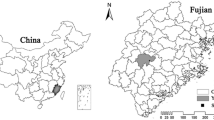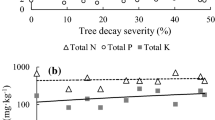Abstract
Evaluation of enzyme activities in combination with taxonomic analyses may help define the mechanisms involved in microbial decomposition of orgaic amendments and biological control of soilborne pathogens. In this study, powdered pine bark was added to nematode-infested soil at rates of 0, 5, 10, 15, 20, 25, 30, 35, 40, 45, and 50 g kg−1. Total fungal populations did not differ among treatments immediately after application of pine bark. After 7 days, fungal populations were positively correlated with increasing levels of pine bark. This increase was sustained through 14 and 21 days.Penicillium chrysogenum andPaecilomves variotii were the predominant fungal species isolated from soil amended with pine bark. Total bacterial populations did not change with addition of pine bark at 0, 7, and 14 days after treatment. At 21 and 63 days, total bacterial populations declined in soil receiving the highest rates of pine bark. Addition of pine bark powder to soil caused a shift in predominant bacterial genera fromBacillus spp. in nonamended soil, toPseudomonas spp. in amended soil. Soil enzyme activities were positively correlated with pine bark rate at all sampling times. Trehalase activity was positively correlated with total fungal populations and with predominant fungal species, but was not related to bacterial populations. The number of non-parasitic (non-stylet bearing) nematodes andMeloidogyne arenaria in soil and roots were not correlated with pine bark rate. However,Heterodera glycines juveniles in roots, and the number of cysts g−1 root, declined with increasing levels of pine bark.
Similar content being viewed by others
References
Baker K F and Cook R J 1974 Biological Control of Plant Pathogens. American Phytopathological Society Press, St. Paul, MN.
Godoy G, Rodríguez-Kábana R, Shelby R A, and Morgan-Jones G 1983 Chitin amendments for control ofMeloidogyne arenaria in infested soil. II. Effects on microbial populations. Nematropica 13, 63–74.
Henderson M E K 1960 Studies on the physiology of lignin decomposition by soil fungi.In The Ecology of Soil Fungi. pp 296–256.
Hofmann E 1963 Die Analyse von Enzymen im Böden.In Modern Methods of Plant Analysis Vol 6 Eds K Paech and M V Tracey. pp 416–423. Springer-Verlag, Berlin.
Hoitink H A J and Kuter G A 1985 Suppression of soilborne diseases of ornamental plants by tree bark composts.In Ecology and Management of Soilborne Plant Pathogens. Eds. C A Parker et al. pp 237–239. American Phytopathological Society Press, St. Paul, MN.
Inbar Y, Boehm M J and Hoitink H A J 1991 Hydrolysis of fluorescein diacetate in sphagnum peat container media for predicting suppressiveness to damping-of caused byPythium ultimum. Soil Biol. Biochem. 23, 479–483.
Katan J 1980 Solar pasteurization of soils for disease control: Prospects and status. Plant Disease 64, 45–54.
Kirk T K and Conners W J 1977 Advances in understanding the microbial degradation of lignin.In Recent Advances in Phytochemistry. Vol. II. The Structure, Biosynthesis, and Degradation of Wood. Eds. F A Loewus and V C Runeckle. pp 369–394. Plenum Press, NY.
Kloepper J W, Rodríguez-Kábana R, McInroy J A and Young R W 1992 Rhizosphere bacteria antagonistic to soybean cyst (Heterodera glycines) and root-knot (Meloidogyne incognita) nematodes: Identification by fatty acid analysis and frequency of biological control activity. Plant and Soil 139, 75–84.
Kokalis-Burelle N, Backman P A, Rodríguez-Kábana R and Ploper L D 1992 potential for biological control of early leafspot of peanut usingBacillus cereus and chitin as foliar amendments. Biological Control 2, 321–328.
Kokalis-Burelle N, Rodríguez-Kábana R, Weaver C F and King P S 1994 Evaluation of powdered pine bark for control ofMeloidogyne arenaria andHeterodera glycines on soybean. Plant and Soil 162, 163–168.
Mian I H, Godoy G, Shelby R A, Rodríguez-Kábana R and Morgan-Jones G 1982 Chitin amendments for control ofMeloidogyne arenaria in infested soil. Nematropica 12, 71–84.
Nelson N 1944 A photometric adaption of the Somogyi method for determination of glucose. J. Biol. Chem. 153, 375–380.
Rodríguez-Kábana R and Pope M H 1981 A simple method for the extraction of nematodes from soil. Nematropica 2, 175–185.
Rodríguez-Kábana R, Morgan-Jones G, Godoy G and Gintis B O 1984 Effectiveness ofGliocladium, Paecilomyces, andVerticillium for control ofMeloidogyne arenaria in field soil. Nematropica 14, 155–170.
Rodríguez-Kábana R and Canullo G H 1992 Cropping systems for the management of phytonematodes. Phytoparasitica 20, 211–224.
Rodríguez-Kábana R, Pinochet J, Robertson D G and Wells L 1992 Crop rotation studies with velvet bean (Mucuna deeringiana) for the management ofMeloidogyne spp. Supplement to Journal of Nematology 24, 662–668.
Rouxel F 1991 Natural suppressiveness of soils to plant diseases.In Biotic Interactions and Soil-borne Diseases. Eds. A B R Beemster et al. pp Elsevier, NY.
Russell E W 1961 The decomposition of plant material.In Soil Conditions and Plant Growth 9th Edition pp 240–263. Wiley Publishers.
SAS Institute, Inc 1987 SAS User's Guide: Statistics, Version 6.04 Edition, Cary, NC: SAS Institute, Inc.
Savoie J M and Gourbiere F 1989 Decomposition of cellulose by species of fungal succession degradingAbies alba needles. FEMS Microbiol. Ecol. 62, 307–314.
Schmitthenner A F and Williams L E 1958 Methods for analysis of soil-borne plant pathogens and associated soil fungi. Ohio Agr. Exp. Sta., Botany and Plant Pathology Mimeo. Series, No. 29.
Smith R E and Rodríguez-Kábana R 1982 The extraction and assay of soil trehalase. Plant and Soil 65, 335–344.
Zeck W M 1971 A rating scheme for field evaluation of root-knot nematode infestation. Plazenschutz-Nacht. 24, 141–144.
Author information
Authors and Affiliations
Additional information
Journal Series Series No. 18-933598 Alabama Agricultural Experiment Station
Rights and permissions
About this article
Cite this article
Kokalis-Burelle, N., Rodríguez-Kábana, R. Changes in populations of soil microorganisms, nematodes, and enzyme activity associated with application of powdered pine bark. Plant Soil 162, 169–175 (1994). https://doi.org/10.1007/BF01347703
Received:
Accepted:
Issue Date:
DOI: https://doi.org/10.1007/BF01347703




